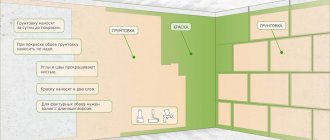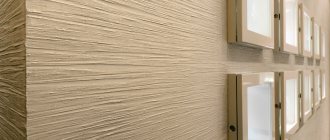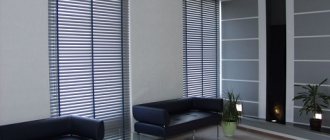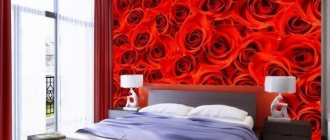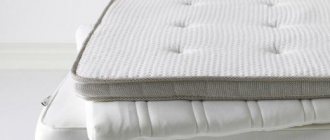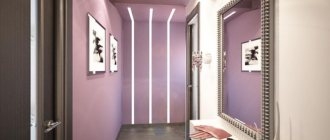The walls in our houses, especially old ones, are most often far from ideal.
There are many ways to fix all chips and imperfections, but most of them require major repairs.
This article will talk about how to visually hide these shortcomings using five types of wallpaper.
Difficulties associated with gluing wallpaper to uneven surfaces
Instead of choosing what to cover with old plaster, try filling up large uneven areas
The installation instructions for roll coverings provide for preliminary preparation of building surfaces. If gluing is carried out without eliminating the relief, the following consequences are likely:
- The relief will be visible through the canvas - this is important for stretchy, smooth wallpaper.
- Sinuses form under the canvas, in the place of which it will swell and peel off. Such consequences are possible when using particularly dense, non-stretchy wallpaper.
Choosing the best option for masking irregularities
| Illustrations | What wallpaper hides uneven walls: 4 types of coatings |
| Non-woven . Fully non-woven wallpaper is rarely found on sale, since this material is most often used as a backing for vinyl. However, non-woven fabric is good because it does not stretch, which means that the relief will appear to a minimum. |
The instructions for gluing non-woven fabric suggest applying glue only to the wall. Since we are talking about finishing problem surfaces, it would be correct to apply glue both to the wall and to the underside of the canvas
It is advisable to buy vinyl coverings with a non-woven backing, as they have less stretch. The denser the canvas, the more likely it is that the relief will not show through it.
What are the best adhesives to use for installation? I recommend the fastest drying glue you can find on sale. The faster the glue dries, the more likely it is that the canvas will not stretch and the relief will not appear.
Thick fiberglass-based wallpaper is used for decorating office premises. But, if you don’t mind a minimalist interior, this finishing material will come in handy.
Choice of texture and color design
| Illustrations | What wallpaper to glue on uneven walls: choosing a decorative design |
| Hot stamping . The coating has a pronounced relief texture. I recommend canvases that hide unevenness with a medium-sized pattern. | |
| Foamed . This is an excellent choice for distressed plaster, as the texture is disordered and there is no symmetrical pattern. This finish best hides unevenness. | |
| Embossed for painting . Despite the pronounced texture, the pattern is symmetrical, and therefore large relief will appear on such surfaces. | |
| Any coverings with a bright print without an ordered pattern . Suitable for masking large level differences. |
What not to glue to crooked plaster
| Illustrations | I absolutely do not recommend it for gluing uneven walls. |
| Paper single-layer coverings . Due to the small thickness, any even slight relief is visible on such surfaces. | |
| Any non-textured canvases with a large, ordered pattern . Such a coating cannot hide the relief. On the contrary, large irregularities will be clearly visible in bright light. | |
| Finishing materials are too heavy . Due to the unevenness of the plaster and the heavy weight, such coatings may fall over time. |
Recommendations for gluing
| Illustrations | How to hang wallpaper on uneven walls |
| We even it out as much as possible . It is clear that you decided to finish uneven surfaces, as there were good reasons for this. |
Most often, uneven walls are plaster from which the old finish is crumbling. If the surface is crumbling, we treat it with deep penetration primers, which will penetrate the structure of the plaster and strengthen it.
Is it possible to glue wallpaper to uneven walls: features
Uneven walls are one of the main problems when renovating an apartment. The flaws can be minor, noticeable only in certain lighting. There may be clearly visible irregularities that can only be corrected with the help of professional finishers. Such walls cannot be painted, applied or decorative plaster; this type of finishing will only highlight the imperfections of the wall. The only option that is suitable for decorating walls with uneven surfaces is to use wallpaper. They will help visually align the walls and partially hide imperfections.
Choosing wallpaper for uneven walls
Those who decide to renovate a house or apartment are often faced with the question of what to do with uneven walls. If you level them using plaster mixtures, then you will need to spend a lot of effort, time and money, plus, carrying out such work requires special skills. So people have a desire to use this method, with which they can simply hide all existing defects on the surface - by hanging wallpaper. This option does exist, but you need to understand that not every type of wallpaper product can be suitable for this purpose. To hide unevenness, you need to choose only thick wallpaper; the option of thin wallpaper is not considered in this case. In this article we will talk about some types of wallpaper that can be used to hide uneven walls.
How to stick thick wallpaper on uneven walls
If there are visually not only defects on the walls, but also unevenness between the wall and the ceiling, you need to cut off the strips with a margin. After gluing and the glue has dried, the excess is cut off with a mounting knife to fit the ruler.
It is better to choose those dense wallpapers that have an overlap. This will allow you to do your work more accurately.
What glue is best for gluing?
Non-woven wallpaper is easy to paste, as the glue is applied to the wall. The strip is easily distributed over the wall surface and does not stretch due to wet glue.
You should use the type of glue recommended by the wallpaper manufacturer. It may seem that this is not economically profitable, since good material is not cheap. But this will ensure good adhesion of the strips to the wall. Typically, glue is sold in the form of a dry powder, which is diluted with water. When purchasing, you need to pay attention to the expiration date of the mixture.
Where to begin
First you need to do the preparatory work. If there are cracks on the wall, then you need to remove the old material and prime the resulting depression. Then seal the crack with putty.
Then apply a primer, it will strengthen the base and make it more convenient for gluing stripes. The drying time for the primer is indicated on the packaging. Typically, primers are used that form a film on the surface after drying.
Gluing non-woven or non-woven fabrics is performed in the following sequence:
- Using a building level, you need to draw a vertical stripe on the wall. The first strip must be strictly aligned with it. You can apply glue to the walls using a foam roller or a wide brush. This must be done carefully and as quickly as possible.
- Apply the strip and carefully align it from top to bottom. This can be done using a soft cloth or a clean foam roller. There is no need to forcefully smooth the canvas onto uneven surfaces, as this will only highlight the defects.
After gluing, unevenness may be visible at the junctions of the walls and ceiling. To hide them, use a ceiling plinth.
Features of gluing in corners
Gluing a solid canvas in a corner, especially if there are defects in the walls, will not work neatly. Pasting of internal corners must be done in the following sequence:
- measure the distance from the last glued strip to the corner;
- cut the wallpaper into two parts, the width of one should be equal to the measured size plus 5 cm;
- then you need to glue the strip so that a slight overlap goes around the corner. Excess wallpaper should be cut off at the corner with a sharp knife. If the angle line is not straight, then you need to use a ruler;
- on the other side, use a plumb line to draw a vertical line at a distance from the corner equal to the width of the remaining strip minus 2 cm. The drawn line will help to glue the wallpaper evenly;
- Apply glue to the wall, align the strip along the drawn line and carefully stick it on. This creates an overlap in the corner. It needs to be cut with a sharp knife.
For walls, it is better not to use sconces and other types of wall lamps, since the light from them in the evening will highlight all the shortcomings. The further the light source is from the wall, the less it will highlight imperfections.
Most defects, such as differences in height, minor depressions and protrusions, will only be noticeable in evening light. This must be taken into account when sealing cracks and small depressions.
If you have experience in finishing work, then it is advisable to correct obvious errors with plaster. For example, too large depressions and cracks will be very difficult to disguise even.
Thick wallpaper will cost more than thin wallpaper, but you should not skimp, as it will help hide imperfections.
When combining strips from different rolls, you need to think about the combination in advance. There should be repeating elements in two views, for example:
- the same texture with different color backgrounds;
- plain version and rolls with ornaments. In this case, the color of the plain fabric will be repeated in the ornament design;
- the same pattern in different colors. This can be a floral ornament on a pastel background or the same motif made on a dark background.
You should not choose wallpaper with a glossy, shiny surface; it is better to choose a matte version. The glossy surface reflects light and highlights imperfections.
You can paste wallpaper at home yourself, choosing rolls of high density. With their help, you can decorate small imperfections in the wall and irregularities at the junction of the wall and ceiling.

